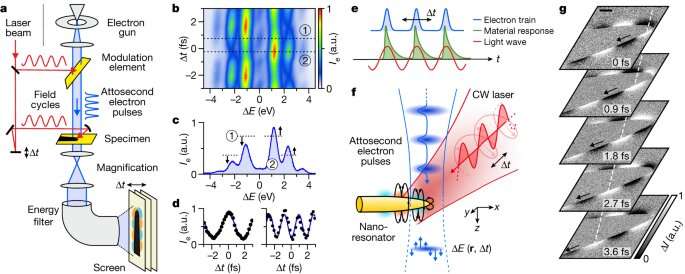This article has been reviewed according to Science X's editorial process and policies. Editors have highlighted the following attributes while ensuring the content's credibility:
fact-checked
peer-reviewed publication
trusted source
proofread
Study demonstrates one of the world's fastest electron microscopes in action

Electron microscopes give us insight into the tiniest details of materials and can visualize, for example, the structure of solids, molecules or nanoparticles with atomic resolution. However, most materials in nature are not static. They constantly interact, move and reshape between initial and final configurations.
One of the most general phenomena is the interaction between light and matter, which is omnipresent in materials such as solar cells, displays or lasers. These interactions are defined by electrons pushed and pulled around by the oscillations of light, and the dynamics are extremely fast: light waves oscillate at attoseconds, the billionth of a billionth of a second.
Until now, it has been very difficult to directly visualize these extremely fast processes in space and time, but that is exactly what a team of physicists from the University of Konstanz has now succeeded in. They recorded movies with attosecond time resolution in a transmission electron microscope, providing new insights into the functionality of nanomaterials and dielectric meta-atoms. They recently published their results in Nature.
Generation of ultrashort electron pulses
"If you look closely, almost all phenomena in optics, nanophotonics or metamaterials occur on time scales below one oscillation period of a light wave," explains Peter Baum, physics professor and head of the Light and Matter Group at the University of Konstanz.
"To film the ultrafast interactions between light and matter, we therefore need a time resolution of attoseconds." To achieve such an extreme recording speed, Baum's research group uses the fast oscillations of a continuous-wave laser to convert the electron beam of an electron microscope into a sequence of ultrashort electron pulses.
In this process, a thin silicon membrane creates a periodic acceleration and deceleration of the electrons. "This modulation causes the electrons to catch up with each other. After some time, they convert into a train of ultrashort pulses," explains David Nabben, doctoral student and first author of the study.
Another laser wave creates the interaction with the sample object. The ultrashort electron pulses are then used to measure the object's response to the laser light, frozen in time like in a stroboscope. In the end, the researchers obtain a movie of the processes with attosecond time resolution.
Investigation of nanophotonic phenomena
In their study, the scientists present several examples of time-resolved measurements in nanomaterials. The experiments show, for example, the emergence of chiral surface waves that can be controlled by the researchers to travel in a specific spatial direction, or characteristic time delays between different modes of radiation from nanoantennas. What is more, the scientists not only investigate such surface phenomena, but also film the electromagnetic processes inside a waveguide material.
The results are highly interesting for further developments in nanophotonics, but also demonstrate the very broad application range of the new attosecond electron microscopy. "The direct measurement of the electromagnetic functionality of materials as a function of space and time is not only of great value for fundamental science, but also opens up the way for new developments in photonic integrated circuits or metamaterials," Nabben says.
More information: Peter Baum, Attosecond electron microscopy of sub-cycle optical dynamics, Nature (2023). DOI: 10.1038/s41586-023-06074-9. www.nature.com/articles/s41586-023-06074-9
Journal information: Nature
Provided by University of Konstanz





















